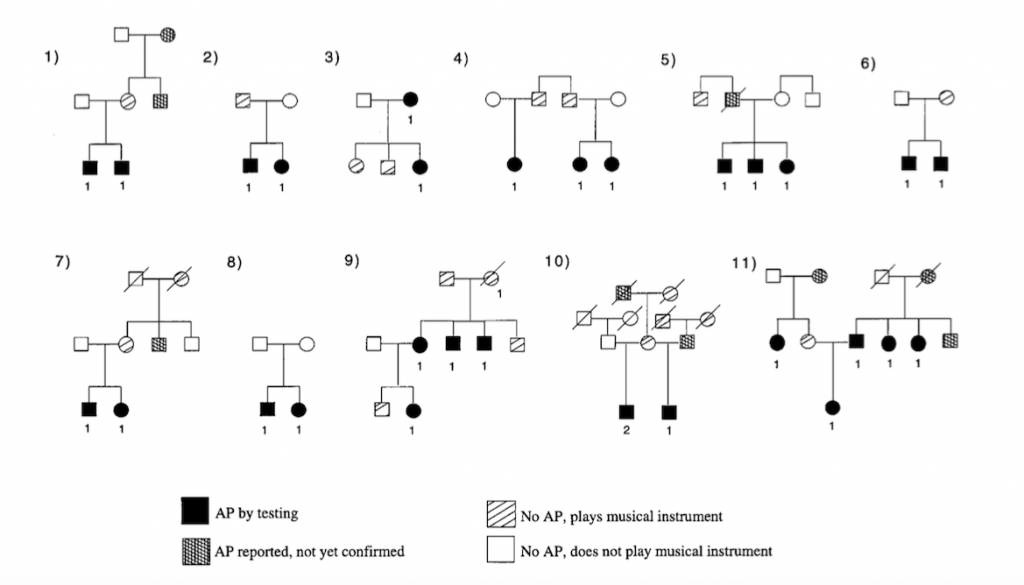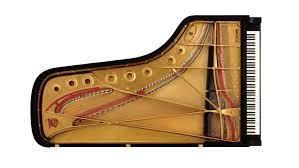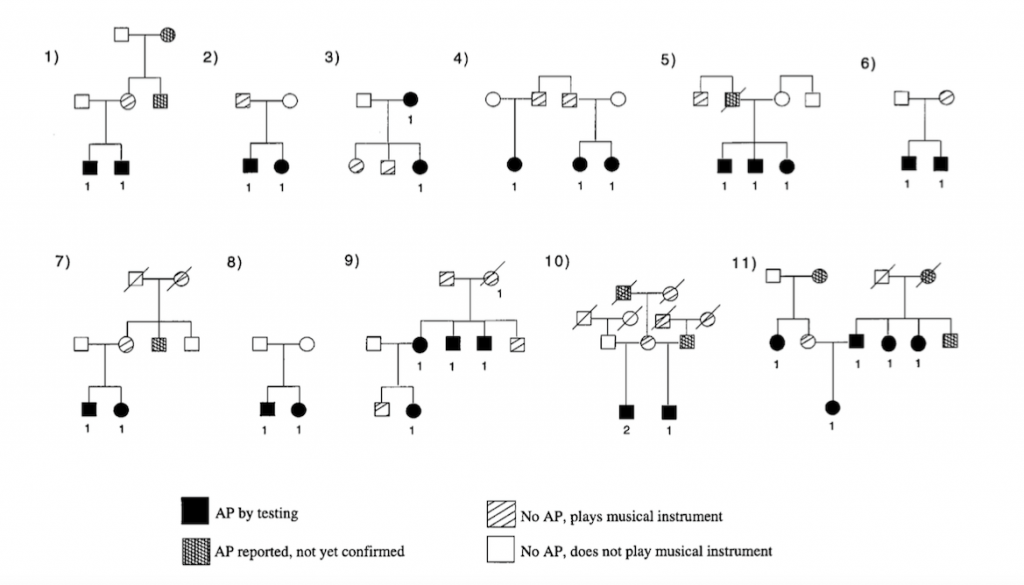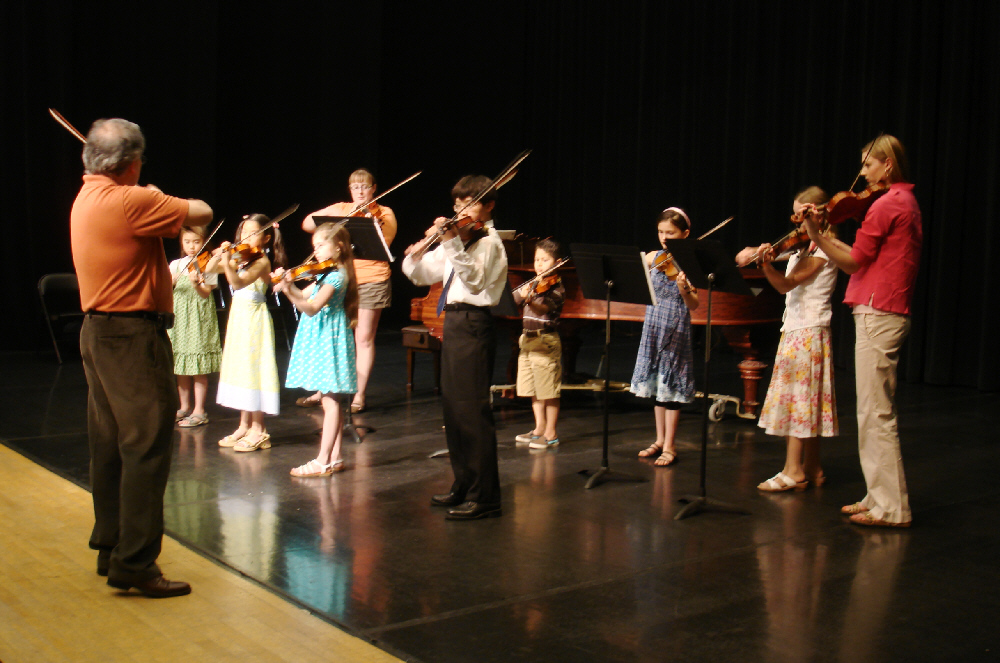
Title of paper under discussion
Absolute Pitch: An Approach for Identification of Genetic and Nongenetic Components
Authors
Siamak Baharloo, Paul A. Johnston, Susan K. Service, Jane Gitschier and Nelson B. Freimer
Journal
American Journal of Human Genetics, vol 62, pp 224–231, 1998
Link to paper (free access)
(with thanks to The Institute for Music and Brain Science for the link)

Overview
Absolute (or perfect) pitch (AP) is the ability to recognise a pitch without an external reference. Siamak Baharloo and his colleagues at the University of California, San Francisco surveyed more than 600 musicians in an attempt “to dissect the influences of early musical training and genetics on the development of this ability”. It transpired that early musical training was “necessary, but not sufficient for the development of AP”, with 40% of musicians who had begun training before the age of 4 claiming to have AP, compared with only 3% of those who began over the age of 9. Family studies pointed to a genetic predisposition, with the potential to develop AP being inherited as a ‘dominant trait’.
The researchers also differentiated between people able to recognise pitches from pure tones, and those only properly able to recognise them from notes played on the piano.
Method
Survey
900 surveys were distributed at the San Francisco Conservatory of Music, University of California San Francisco Symphony, Berkeley Music School at the University of California, Curtis Institute of Music, San Francisco Symphony Youth Orchestra, Peabody Conservatory of Music, La Scala Opera, Aspen Music School, and Interlochen Center for the Arts, with 612 completed and returned.
The survey set out, through its questions, to determine: 1) the percentage of people in the sample claiming to possess AP (by asking about their ability to identify and sing pitches without reference) 2) whether there is a correlation between the starting age of musical training and the development of AP (by finding out about their early music lessons) , and 3) whether AP runs in families (by asking about the prevalence of AP among their first-degree relatives).

Interviews and testing
Seeking to extend the scope of their investigation beyond the limitations of a written survey, the researchers asked some of the participants to come into the lab for in-person testing and interviews; by the end of the project 99 self-declared AP musicians and 12 self-declared non-AP musicians had been tested.
Each participant sat through two series of tests. The first involved listening to a series of 40 pure tones (sine-wave tones, digitally synthesised) in ‘pseudo-random’ order, with successive tones always separated by at least two octaves and a semitone; participants were asked to name each tone as soon as they heard it. The second involved the same procedure, but this time with piano tones (sampled from a 9-foot Steinway Grand).
Each participant was given one point for every correctly identified pitch. Those aged under 45 got 0.75 points for answers within a semitone, whereas those aged over 45 still got a whole point – because AP is known to shift by as much a semitone with age.
Each participant was also interviewed in more detail about family members with or without AP; where possible, these members were brought into the lab to test their AP.

Results
Survey
The initial survey revealed 15% of respondents as claiming to possess AP. Most of these self-declared AP musicians (92% of them) claimed not just an ability to recognise pitches without reference, but also to be able to sing such pitches; and 79% of them claimed they could identify pitch from any instrument.
Regarding the AP-status of family members, 48% of self-declared AP musicians indicated that they had first-degree relatives who also possessed AP. In contrast, only 14% of self-declared non-AP musicians reported first-degree relatives with AP. Further analysis of families receiving early-years music training showed that amongst the siblings of self-declared AP musicians, 9 out of 15 also had AP; but amongst the siblings of self-declared non-AP musicians, only 2 out of 23 had AP.
Interviews and testing
By pooling the scores and looking at how each participant compared with the sample averages, the researchers came up with four categories of AP musician according to their ability to pitch, without reference, pure tones and piano tones: AP-1 (excellent at pure tones and piano tones), AP-2 (good at pure tones, good at pitching piano tones), AP-3 (good at pure tones, average at piano tones), AP-4 (poor at pure tones, good at piano tones). It turned out that about 70% of the musicians claiming to have AP were in the top (AP-1) category, with 5% in AP-2, 3% in AP-3, 5% in AP-4… and 17% not qualifying for any AP category.
When it came to interviews to determine the family prevalence of AP, eleven of the AP-1 musicians offered relatives for testing. It turned out that ten of those musicians had at least one relative who was also AP-1 – including one family with five AP-1 members and another with four. The remaining AP-1 musician brought his brother along for testing, who turned out to be AP-2.

Discussion
Our researchers set out to explore the interplay between nature and nurture in the development of absolute (perfect) pitch. They used a larger sample of musicians than previous such studies, and although the initial survey inevitably risked some sampling bias and relied on subjectivity of participants responses, the subsequent lab testing added a critical layer of objectivity to the project.
The results confirmed that early musical training is important for the development of AP, since “nearly all self-reported AP possessors stated that their formal musical training had begun at age ≤ 6 years”. Such a correlation between early musical training and AP, the researchers suggest, “could be explained by a developmental critical period for AP, during which the brains of some individuals are particularly amenable to the establishment of new circuits or to the fine-tuning of pre-existing circuits involved in pitch perception.” They go on to note that “The existence of such a critical period has been demonstrated for singing behaviour in songbirds and for language development in humans.” An alternative suggestion is that people with a genetic disposition to AP may simply be “more likely than others to start musical training early in life”.

Whatever the importance of early musical training to the development of AP, it is clearly not the whole story. Although nearly all the self-declared AP possessors in the study reported that their musical training had started at age ≤ 6 years, the majority of respondents in the survey who reported such training at age ≤ 6 years stated they do not possess AP. The researchers conclude that their results “are consistent with the hypothesis that early musical training is necessary but not sufficient for the development of AP.”
They go on to write “The fact that most individuals with early musical training did not develop AP suggests a genetic contribution to the development of [AP]”. Together with patterns revealed in the AP family trees, this points to AP being inherited as a ‘dominant’ trait (like brown eyes or curly hair) – but with “incomplete penetrance”, meaning the AP is not always apparent in someone ‘carrying’ it, for instance if they haven’t received early musical training.


Baharloo and his colleagues look forward in the paper to identifying the gene(s) responsible for AP. Their definition of AP categories will, they hope, prove useful in sharpening this search, proposing “to restrict future genetic mapping studies to AP-1 individuals and their families”. Furthermore, the different categories may, they claim, help reveal different underlying processes in pitch perception, suggesting that “whereas AP-1 subjects can identify the pitch of tones simply on the basis of the fundamental frequency of the tones, AP-4 individuals may have an inherent ability to make use of the information provided by qualities such as the timbre and harmonics of tones, to accurately identify pitches.”
In short, the paper establishes AP as a trait reliant on nature and nurture: “we have confirmed that early musical training is essential for the development of AP and have operationally defined AP in a way that should allow us to identify genetic variations that can lead to the development of this fascinating ability.”
Coda
Notation II – Pierre Boulez
Berliner Philharmoniker, cond. Boulez
Hi Adrian!
Interesting article as always.
In the book that I’m reading (The musician’s guide to acoustics) there’s an interesting little paragraph about the absolute pitch. One interesting feature of absolute pitch recognition is that apparently when errors occur they are often octave errors: e.g. a C5 described as C4 or C6. This lends support to the idea that the brain recognises two aspects of pitch: tone height and chroma, where chroma is a sort of ‘finger print’ that a sound ‘leaves’ on the basilar membrane consisting of the harmonic structure of a particular sound.
The shift that occurs with age in the internal scale of absolute pitch is explained (in the same book) with the change in the elastic properties of the basilar membrane: this creates a shift of the point of maximum amplitude generated by a certain pitch on the basilar membrane, stimulating a different bungle of nerve fibres resulting – for example – in hearing a C4sharp when a C4 is played.
Thanks!
Marco
Hi Marco, thanks for the comment! I’d never heard the octave error quoted before, I can see it begs important questions re auditory processing. Changes in AP with age are also fascinating – if frustrating to AP possessors. The basilar membrane elasticity explanation sounds plausible, but it would seem that this research – https://asa.scitation.org/doi/10.1121/1.4969887 – couldn’t find evidence for it. I’ll ask Sam Leak if he has any ideas..